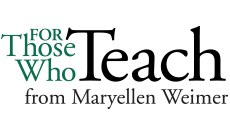I’ve been writing for years that we need to teach in ways that encourage students to take more responsibility for their learning. Recently, it became clear that my thinking on this needed more detail and depth. I’ve been saying that it means students should be doing the learning tasks that make them stronger learners. They should be figuring out what’s important in the reading, rather than having the teacher to tell them. They should be taking notes rather than expecting to get the teacher’s slides and notes.
 It was a question in a workshop that made me realize my answer wasn’t wrong, just incomplete. “In a formal learning situation, like a course, what responsibilities do students have?” After further reflection, my answer to that question is that the responsibilities exist across three areas.
It was a question in a workshop that made me realize my answer wasn’t wrong, just incomplete. “In a formal learning situation, like a course, what responsibilities do students have?” After further reflection, my answer to that question is that the responsibilities exist across three areas.
1. Students have responsibility for: One word says it all, LEARNING. Teachers have lots of responsibilities when it comes to promoting and supporting learning and we can do all sorts of things that facilitate the process, but at the end of the day, it’s the students who have to learn the content. We cannot learn anything for students, as much as we’d like to and as hard as we sometimes try.
2. Students should have responsibility for: All those learning-related tasks that expedite learning and develop learning skills. And it’s these responsibilities that students are most reluctant to accept. They’d much rather have the teacher summarize the lecture, solve the problems, provide the PowerPoint slides, and award credit for effort. In many cases, it’s more than just a preference. A lot of students believe it’s the teacher’s job to provide study guides, review sessions, and exams that aren’t too taxing.
Unfortunately, a wide-range of teacher behaviors tend to support these student beliefs. Teachers make the decisions and do the learning tasks that should be done by students. If students don’t want to make decisions related to learning or we worry they won’t make very good decisions, we go ahead and tell them what to do. We specify word-counts, font size, number of references, and deadlines. We require attendance, participation, and strictly enforce deadlines. In our commitment to help students succeed, we do for them what they should be doing for themselves.
If students are serious about learning—even if they simply want to pass the course or their only motivation is a good grade—then students should have responsibility for coming to class prepared, taking notes, voluntarily participating, confronting their preparation and their performance, and developing their skills as learners.
Most of us do tell students that these are their responsibilities, but some (often it’s many) students do not believe us or chose to ignore what we say. The alternative is to develop policies, practices, activities, and assignments that hold students responsible for these learning-related tasks. And the pedagogical literature is replete with ideas. This collection highlights more than 20 strategies and approaches from a variety of journals and other resources. Preview here »
3. Students could share responsibility for: How the class is set-up and will be run, creating and maintaining climates conducive to learning, decision-making regarding how they will be learning and how that learning will be assessed, and providing feedback that helps their peers improve.
These are areas where faculty typically make decisions but where decision-making could be shared with students. The key is shared decision-making, but with the teacher in charge of what and how much is shared. Students, new to the content and new to college level learning, cannot be expected to automatically make good learning decisions, especially if they are used to teachers making those decisions made for them. It takes time, effort, and experience to become an independent, autonomous, self-directed learner.
However, as you can see in the collection of resources, there are faculty who involve students in syllabus construction. They let students propose policies. They give students the opportunity to suggest additional course goals. Students are given some assignment choices or allowed to determine the relative weight of say, exams and quizzes. Students can set assignment deadlines, sometimes within specified time windows. Other faculty invite students to identify peer behaviors that contribute to or compromise their efforts to learn. If work is completed in groups, students can provide feedback, sometimes evaluate the contributions of group members. Peers, using rubrics and with some constraints, can “grade” each other’s quizzes.
When we relinquish some control and empower students to assume responsibility for learning-related activities, their motivation and self-directedness increases. That shared decision-making often motivates students to start taking on even more of those responsibilities essential for learning.
A question for readers: In what ways do you encourage students to take responsibility for their learning? Please share in the comment box.






